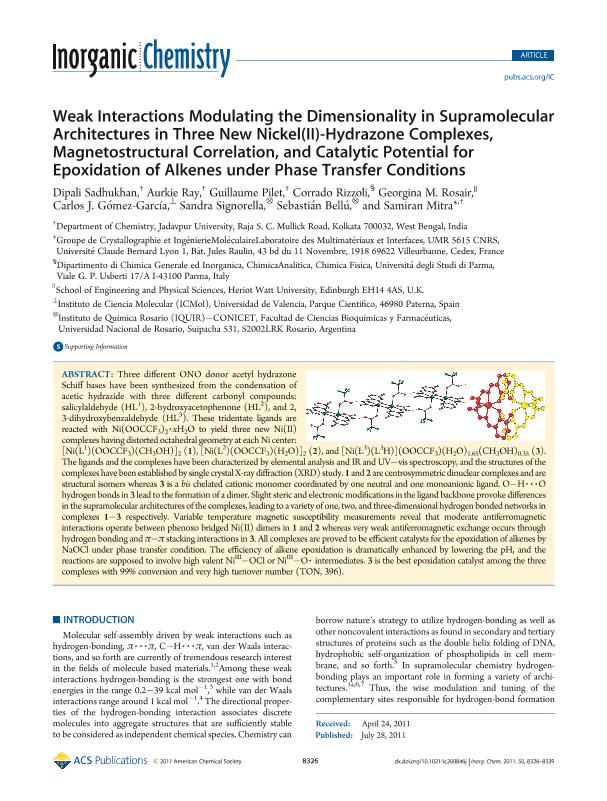Mostrar el registro sencillo del ítem
dc.contributor.author
Sadhukhan, Dipali
dc.contributor.author
Ray, Aurkie
dc.contributor.author
Pilet, Guillaume
dc.contributor.author
Rizzoli, Corrado
dc.contributor.author
Rosair, Georgina M.
dc.contributor.author
Gómez García, Carlos J.
dc.contributor.author
Signorella, Sandra Rosanna

dc.contributor.author
Bellú, Sebastián Eduardo

dc.contributor.author
Mitra, Samiran
dc.date.available
2021-03-03T12:38:57Z
dc.date.issued
2011-09-05
dc.identifier.citation
Sadhukhan, Dipali; Ray, Aurkie; Pilet, Guillaume; Rizzoli, Corrado; Rosair, Georgina M.; et al.; Weak interactions modulating the dimensionality in supramolecular architectures in three new nickel(II)-hydrazone complexes, magnetostructural correlation, and catalytic potential for epoxidation of alkenes under phase transfer conditions; American Chemical Society; Inorganic Chemistry; 50; 17; 5-9-2011; 8326-8339
dc.identifier.issn
0020-1669
dc.identifier.uri
http://hdl.handle.net/11336/127238
dc.description.abstract
Three different ONO donor acetyl hydrazone Schiff bases have been synthesized from the condensation of acetic hydrazide with three different carbonyl compounds: salicylaldehyde (HL 1), 2-hydroxyacetophenone (HL 2), and 2, 3-dihydroxybenzaldehyde (HL 3). These tridentate ligands are reacted with Ni(OOCCF 3) 2· xH 2O to yield three new Ni(II) complexes having distorted octahedral geometry at each Ni center: [Ni(L 1)(OOCCF 3)(CH 3OH)] 2 (1), [Ni(L 2)(OOCCF 3)(H 2O)] 2 (2), and [Ni(L 3)(L 3H)] (OOCCF 3)(H 2O) 1.65(CH 3OH) 0.35 (3). The ligands and the complexes have been characterized by elemental analysis and IR and UV-vis spectroscopy, and the structures of the complexes have been established by single crystal X-ray diffraction (XRD) study. 1 and 2 are centrosymmetric dinuclear complexes and are structural isomers whereas 3 is a bis chelated cationic monomer coordinated by one neutral and one monoanionic ligand. O-H⋯O hydrogen bonds in 3 lead to the formation of a dimer. Slight steric and electronic modifications in the ligand backbone provoke differences in the supramolecular architectures of the complexes, leading to a variety of one, two, and three-dimensional hydrogen bonded networks in complexes 1-3 respectively. Variable temperature magnetic susceptibility measurements reveal that moderate antiferromagnetic interactions operate between phenoxo bridged Ni(II) dimers in 1 and 2 whereas very weak antiferromagnetic exchange occurs through hydrogen bonding and π-π stacking interactions in 3. All complexes are proved to be efficient catalysts for the epoxidation of alkenes by NaOCl under phase transfer condition. The efficiency of alkene epoxidation is dramatically enhanced by lowering the pH, and the reactions are supposed to involve high valent Ni III-OCl or Ni III-O· intermediates. 3 is the best epoxidation catalyst among the three complexes with 99% conversion and very high turnover number (TON, 396). © 2011 American Chemical Society.
dc.format
application/pdf
dc.language.iso
eng
dc.publisher
American Chemical Society

dc.rights
info:eu-repo/semantics/openAccess
dc.rights.uri
https://creativecommons.org/licenses/by-nc-sa/2.5/ar/
dc.subject
Hidrazone
dc.subject
Nickel(II)
dc.subject
Epoxidation
dc.subject
Alkene
dc.subject.classification
Química Inorgánica y Nuclear

dc.subject.classification
Ciencias Químicas

dc.subject.classification
CIENCIAS NATURALES Y EXACTAS

dc.title
Weak interactions modulating the dimensionality in supramolecular architectures in three new nickel(II)-hydrazone complexes, magnetostructural correlation, and catalytic potential for epoxidation of alkenes under phase transfer conditions
dc.type
info:eu-repo/semantics/article
dc.type
info:ar-repo/semantics/artículo
dc.type
info:eu-repo/semantics/publishedVersion
dc.date.updated
2020-12-22T15:48:22Z
dc.journal.volume
50
dc.journal.number
17
dc.journal.pagination
8326-8339
dc.journal.pais
Estados Unidos

dc.journal.ciudad
Washington D. C.
dc.description.fil
Fil: Sadhukhan, Dipali. Jadavpur University; India
dc.description.fil
Fil: Ray, Aurkie. Jadavpur University; India
dc.description.fil
Fil: Pilet, Guillaume. Université Claude Bernard Lyon 1; Francia. Centre National de la Recherche Scientifique; Francia
dc.description.fil
Fil: Rizzoli, Corrado. Università di Parma; Italia
dc.description.fil
Fil: Rosair, Georgina M.. Heriot Watt University, Edinburgh; Reino Unido
dc.description.fil
Fil: Gómez García, Carlos J.. Universidad de Valencia; España
dc.description.fil
Fil: Signorella, Sandra Rosanna. Consejo Nacional de Investigaciones Científicas y Técnicas. Centro Científico Tecnológico Conicet - Rosario. Instituto de Química Rosario. Universidad Nacional de Rosario. Facultad de Ciencias Bioquímicas y Farmacéuticas. Instituto de Química Rosario; Argentina
dc.description.fil
Fil: Bellú, Sebastián Eduardo. Consejo Nacional de Investigaciones Científicas y Técnicas. Centro Científico Tecnológico Conicet - Rosario. Instituto de Química Rosario. Universidad Nacional de Rosario. Facultad de Ciencias Bioquímicas y Farmacéuticas. Instituto de Química Rosario; Argentina
dc.description.fil
Fil: Mitra, Samiran. Jadavpur University; India
dc.journal.title
Inorganic Chemistry

dc.relation.alternativeid
info:eu-repo/semantics/altIdentifier/doi/http://dx.doi.org//10.1021/ic200846j
dc.relation.alternativeid
info:eu-repo/semantics/altIdentifier/url/https://pubs.acs.org/doi/10.1021/ic200846j
Archivos asociados
